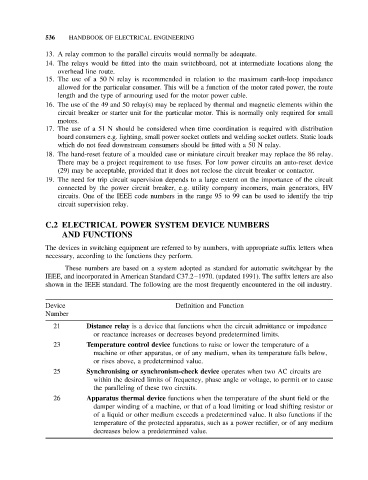Page 545 - Handbook of Electrical Engineering
P. 545
536 HANDBOOK OF ELECTRICAL ENGINEERING
13. A relay common to the parallel circuits would normally be adequate.
14. The relays would be fitted into the main switchboard, not at intermediate locations along the
overhead line route.
15. The use of a 50 N relay is recommended in relation to the maximum earth-loop impedance
allowed for the particular consumer. This will be a function of the motor rated power, the route
length and the type of armouring used for the motor power cable.
16. The use of the 49 and 50 relay(s) may be replaced by thermal and magnetic elements within the
circuit breaker or starter unit for the particular motor. This is normally only required for small
motors.
17. The use of a 51 N should be considered when time coordination is required with distribution
board consumers e.g. lighting, small power socket outlets and welding socket outlets. Static loads
which do not feed downstream consumers should be fitted with a 50 N relay.
18. The hand-reset feature of a moulded case or miniature circuit breaker may replace the 86 relay.
There may be a project requirement to use fuses. For low power circuits an auto-reset device
(29) may be acceptable, provided that it does not reclose the circuit breaker or contactor.
19. The need for trip circuit supervision depends to a large extent on the importance of the circuit
connected by the power circuit breaker, e.g. utility company incomers, main generators, HV
circuits. One of the IEEE code numbers in the range 95 to 99 can be used to identify the trip
circuit supervision relay.
C.2 ELECTRICAL POWER SYSTEM DEVICE NUMBERS
AND FUNCTIONS
The devices in switching equipment are referred to by numbers, with appropriate suffix letters when
necessary, according to the functions they perform.
These numbers are based on a system adopted as standard for automatic switchgear by the
IEEE, and incorporated in American Standard C37.2–1970. (updated 1991). The suffix letters are also
shown in the IEEE standard. The following are the most frequently encountered in the oil industry.
Device Definition and Function
Number
21 Distance relay is a device that functions when the circuit admittance or impedance
or reactance increases or decreases beyond predetermined limits.
23 Temperature control device functions to raise or lower the temperature of a
machine or other apparatus, or of any medium, when its temperature falls below,
or rises above, a predetermined value.
25 Synchronising or synchronism-check device operates when two AC circuits are
within the desired limits of frequency, phase angle or voltage, to permit or to cause
the paralleling of these two circuits.
26 Apparatus thermal device functions when the temperature of the shunt field or the
damper winding of a machine, or that of a load limiting or load shifting resistor or
of a liquid or other medium exceeds a predetermined value. It also functions if the
temperature of the protected apparatus, such as a power rectifier, or of any medium
decreases below a predetermined value.

